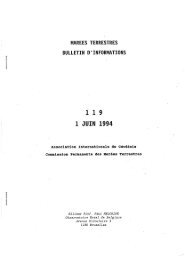marees terrestres bulletin d'informations - Université de la Polynésie ...
marees terrestres bulletin d'informations - Université de la Polynésie ...
marees terrestres bulletin d'informations - Université de la Polynésie ...
You also want an ePaper? Increase the reach of your titles
YUMPU automatically turns print PDFs into web optimized ePapers that Google loves.
Superconducting Gravimeter OSG-050 at the Station Pecný, Czech Republic<br />
Vojtech Pálinkás, Jakub Kostelecký<br />
Research Institute of Geo<strong>de</strong>sy, Topography and Cartography, Geo<strong>de</strong>tic Observatory Pecný, CZ –<br />
251 65 Ondrejov 244, vojtech.palinkas@pecny.cz<br />
Abstract<br />
The Pecný station is equipped by first-rate instrumentations in the field of terrestrial<br />
gravimetry thanks to the absolute gravimeter (AG) FG5#215 and superconducting gravimeter (SG)<br />
OSG-050. Repeated AG observations at the Pecný station allowed to <strong>de</strong>termine the two important<br />
parameters of the SG, its scale and drift. The repeatability of the FG5#215 has been also computed<br />
from combined time series.<br />
One year of SG observations showed the sizeable improvement of earth ti<strong>de</strong>s observations<br />
respect to the existing observations with spring gravimeters and necessity to improve the method of<br />
air pressure effect correction by the single admittance. The noise of OSG-050 in the normal mo<strong>de</strong><br />
band is higher than it would be expected. Small improvement of the noise characteristic was<br />
achieved by careful setting of <strong>de</strong>war pressure.<br />
1. Introduction<br />
Continuous tidal observations by spring gravimeters have been carried out at the station<br />
Pecný since early seventies of the <strong>la</strong>st century (Broz et al. 2005). Different type of spring<br />
gravimeters (Askania Gs11, Gs15, L&R, ZLS) has been used for observations . Of course, during<br />
this long period, the gravimeters and registration was dramatically improved. Methods of<br />
calibration, digital registration, and feedback system <strong>de</strong>velopment were milestones of observation<br />
improvements (Brož et al., 2002; Pálinkáš, 2006). These improvements allowed to increase the<br />
measurement accuracy more than 10 times during 30 years. The standard <strong>de</strong>viation of the observed<br />
hourly ordinate on the level of 0.1 Gal was achieved which is comparable with ol<strong>de</strong>r type of SGs<br />
(Ducarme et al., 2002). Unfortunately this high accuracy is relevant only for the short-period ti<strong>de</strong>s<br />
due to the instrumental drift. The drift of spring gravimeters at Pecný can be consi<strong>de</strong>red as linear for<br />
the period below one week in spite of the temperature and humidity control at the station with<br />
precision of 0.1 o C and 1%, respectively.<br />
Fig. 1. The absolute gravimeter FG5#215 and the superconducting gravimeter OSG-050 at the Pecný station<br />
11819



